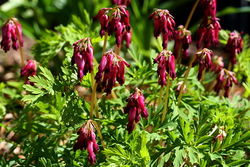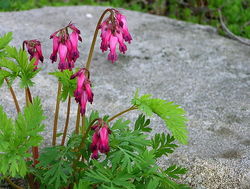Turkey corn
| Turkey corn |
|---|

|
| Scientific Classification |
|
| Scientific name |
|
Dicentra eximia |
| Picture of the Turkey Corn |
Turkey corn is a species of flowering plant known by the scientific name Dicentra eximia (also known commonly as Fringed Bleeding heart and Wild Bleeding Heart). They are herbaceous perennials with dark pink to a reddish purple flowers. Turkey corn is planted by gardeners as an ornamental due to its colorful flowers that are almost in the shape of hearts. They also have green leaves that are quite fern-like. They are native to the eastern United States areas including the Appalachian mountains. Most parts of this plant is toxic to us due to the alkaloids the plant possesses.
Body Design
The flowers of the Turkey corn range in appearance of a dark pink to a purple tinted red color. Near the top, these flowers look heart-shaped.[2] The Turkey corn will grow to be about one foot and three inches tall. The color of the leaves/foliage range in shades of green.[3] The leaves of the Turkey Corn looks alike those of a fern.[4]
The leaves grow from the foundation of the plant. They are made of two or more leaf-like structures each and at their edges they have lobes. The Turkey Corn has four petals on each flower and four sepals along with six stamen.[5]
Life Cycle
The Life cycle of the turkey corn, as any plant, begins with the seed. The seeds should be planted in moist soil, while its about sixty-four to seventy-one degrees Fahrenheit. This planting season would be approximately fall and spring. It can take these seeds anywhere from one month to about six months to germinate![6] The Dicentra emimia flowers from spring through early summer, approximately April-July. They are herbacous perennials. [2] The fruit the Turkey Corn produces are pods that contain seeds that become dark brown when they are ripe and produce elaiosomes (which are white colored). Their fruiting period begins in the summer and goes through the fall. [7]
Besides planting seeds the Bleeding Hearts(Genus Dicentra) use a form of reproduction called the alternation of generations. Beginning with mitosis, the zygote becomes an adult sporophyte then meiosis takes over and it produces spores. These spores then become gametophytes. Once they are fertilized the seeds are formed in the pods. [8]
Ecology
Turkey corn is indigenous to the Appalachian Mountains of the Eastern United States. They tend to be found growing on the floors of forests as they do need shade to grow well. Year round the turkey corn needs damp soil which provides it's 'comfort zone'.[2] It requires an average amount of water and the water needs to be met routinely.[3]
Turkey corn is not just wild, it is used in gardens! This herbaceous perennial brings life, charm and style to the garden.[9] It impacts the environment by being shelter for small organisms, being a source of nectar for hummingbirds and ants feed off of the seeds for survival. These ants are thus administering the seeds and helping the plant grow and spread! [10] Slugs, snails and aphids can become a disturbance to the new leaves. The Dicentra eximia is defiant towards deer. It is not invasive towards it's environment! The Turkey Corn can also get diseases such as Donwny mildew, Verticillium wilt, Viruses, Rust and Fungal leaf spots. [11]
Poisonous Qualities
As seemingly beautiful and attractive the Turkey corn seems, it has toxins called alkaloids. These toxic alkaloids can be found in the stems, leaves, and roots of the plant. If the Turkey corn is somehow ingested by a human or animal it bears lovely consequences, which include, puking, involuntary muscle contractions (known as convulsions), diarrhea, and defective breathing.[12] The main alkaloids that cause these affects are protopine and dicentrine.[13]
Alkaloids is a type of chemical compound that has nitrogen.[14] They are a plant secondary metabolite, and are among the biggest of the groups. They can also be found caffeine, nicotine (which are addictive) as well as important medication. In the plant, this toxicity from the alkaloids are used as a safety mechanism to ward off any harmful pathogen or predator. We can use these alkaloids to fight against undesirable illness and herbivores, pathogens, and cancer cells! The Turkey corn will cause a range of severity of effects based on how heavily the alkaloids were ingested.[15]
Video
Shows different parts of the Turkey Corn.
References
- ↑ USDA Agriculture Resources USDA Natural Resources Conservation Service. Web. assessed December 20, 2017.author unknown.
- ↑ 2.0 2.1 2.2 Dicentra eximia missouribotanicalgarden. Web. Accessed December 28th,2017.Author Unknown
- ↑ 3.0 3.1 Common Name:Fringed Bleeding Heart Waltersgardens. Web. accessed January 14, 2018. Author Unknown
- ↑ Wild bleeding heart or turkey corn North Creek Nursuries. Web. accessed January 20, 2018. Author Unknown
- ↑ wild bleeding-heart Go Botany. Web. accessed January 20, 2018. Author Unknown
- ↑ Dicentra eximia 'Fernleaf Dicentra' Seedaholic. Web. accessed January 15, 2018 Author Unknown
- ↑ Fringed Bleeding Heart (Dicentra eximia) Plants database. Web. Accessed January 20, 2018. Author Unknown
- ↑ Juszczyk Laura. Reproduction Pacific Bleeding Hearts. Web. accessed January 21, 2018.
- ↑ Bleeding Heart Dicentra eximia Plant Finder. Web. accessed January 21, 2018.Author Unknown
- ↑ Dicentra eximia fringed bleeding heart American Beauties Native Plants. Web. accessed January 21, 2018. Author Unknown
- ↑ Cornell University. Fringed bleeding heart Cornell University Published in 2006.
- ↑ The Poison Plant Patch Nova Scotia Museum. Web. accessed January 13,2018. Author Unknown
- ↑ Manske, R. H. F. THE ALKALOIDS OF FUMARACEOUS PLANTS: VII. Dicentra eximia (KER) TORR. Canadian Journal of Research. Web. Published on April 12, 2011
- ↑ Alkaloid - Role In The Plant, Role In Animals, Medical Use, Alkaloids For Pain And Pleasure Science.j.rank. Web. accessed on January 30th, 2018. Author Unknown
- ↑ Fett-Neto, Germano. Plant Alkaloids: Main Features, Toxicity, and Mechanisms of Action SpringerLink. Web. Published on August 7th, 2015




